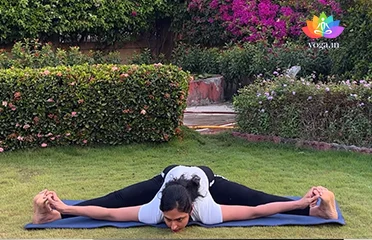Anjaneyasana (Crescent Moon Pose)
आंजनेयासन / Crescent Moon Pose
The Sanskrit name is derived from Anjane (आंजने) meaning Hanuman, [�K]
Astavakrasana (Eight-Angle Pose)
अष्टवक्रासन / Eight-Angle Pose
The sanskrit name is derived from ashta (अष्ट) meaning eight, Vakra [�K]
Bhadrasana (Gracious Pose | Butterfly Po
भद्रासन / Gracious Pose | Butterfly Pose
The Sanskrit name is derived from Bhadra (भद्रा) meaning gracious, [�K]
Hanumanasana (Monkey Pose)
हनुमानासन / Monkey Pose
The Sanskrit name is derived from the Hindu God -Hanuman (हनुमान) [�K]
Jathara Parivartanasana (The Abdominal T
ञठर परिवर्तनासन / The Abdominal Twist
The Sanskrit name is derived from Jathara (ञठर) meaning belly or abdomen, [�K]
Padmasana (Lotus Pose)
पद्मासन / Lotus Pose
The Sanskrit name is derived from Padma (पद्मा) meaning lotus and [�K]
Sarvangasana (Shoulderstand)
सर्वाङ्गासनI / Shoulderstand
The Sanskrit name is derived from Sarva (सर्वाङ्ग) meaning all, [�K]
Sirsasana (Headstand)
शीर्षासन / Headstand
The Sanskrit name is derived from Sirsa (शीर्ष) meaning head and asana [�K]
Supta Padangusthasana (Reclining Posture
सुप्त पदंगुष्टासन / Reclining Posture
The Sanskrit name is derived from Supta (सुप्त) meaning 'supine or [�K]
Upavishta Konasana (Wide-Angled Seated F
उपविष्ट कोनासन / Wide-Angled Seated Forward Bend
The Sanskrit name is derived from Upavistha (उपविष्ट) means open/seated, [�K]
How Yoga Can Help Cure Hydrocele:
Hydrocele is a condition characterized by the accumulation of fluid around the testicles, leading to swelling in the scrotum. Yoga can help in managing and alleviating the symptoms of hydrocele by improving blood circulation, reducing inflammation, and promoting relaxation. Specific yoga postures and breathing exercises can aid in relieving discomfort and supporting overall reproductive health.
Understanding Hydrocele:
A hydrocele is a fluid-filled sac surrounding a testicle that causes swelling in the scrotum. It is commonly found in newborns but can also occur in adults due to injury, inflammation, or underlying medical conditions. While hydrocele is usually painless and harmless, it can cause discomfort and affect the quality of life if it becomes large or symptomatic.
Yoga’s Role in Relieving Hydrocele:
Yoga can be beneficial in alleviating the symptoms of hydrocele through various practices that enhance blood flow, reduce stress, and support the lymphatic system. Gentle asanas (postures) can improve circulation in the pelvic region, while pranayama (breathing exercises) can reduce inflammation and promote relaxation. Regular yoga practice can help maintain overall reproductive health and well-being.
Key Factors Contributing to Hydrocele:
Several factors can contribute to the development of hydrocele, including:
- Congenital Conditions: Hydrocele can be present at birth due to an incomplete closure of the processus vaginalis.
- Injury: Trauma to the scrotum or groin area can lead to hydrocele.
- Infections: Infections in the testicles or epididymis can cause fluid accumulation.
- Inflammation: Inflammatory conditions like epididymitis can result in hydrocele.
- Underlying Medical Conditions: Issues such as heart failure or kidney disease can contribute to fluid retention and hydrocele.
Symptoms of Hydrocele:
Common symptoms of hydrocele include:
- Swelling in the Scrotum: A noticeable enlargement of the scrotum due to fluid buildup.
- Heaviness in the Scrotum: A feeling of weight or fullness in the scrotal area.
- Discomfort or Pain: Mild pain or discomfort in the scrotum, particularly when moving or exerting pressure.
- Changes in Scrotal Size: The size of the swelling may change throughout the day or with different activities.
- Visible Fluid Accumulation: In some cases, the fluid can be seen through the skin of the scrotum when a light is shined on it.
Treatment of Hydrocele through Yoga and Pranayama:
Yoga and pranayama can be highly effective in managing hydrocele. Some beneficial practices include:
Specific Yoga Poses:
- Viparita Karani (Legs-Up-the-Wall Pose): Improves circulation and reduces swelling.
- Supta Baddha Konasana (Reclining Bound Angle Pose): Opens the pelvic area and promotes relaxation.
Pranayama Exercises:
- Anulom Vilom (Alternate Nostril Breathing): Balances the body and reduces stress.
- Nadi Shodhana (Alternate Nostril Breathing): Similar to Anulom Vilom, it helps in balancing energy channels.
Diet for Hydrocele:
A balanced diet can help manage hydrocele. Recommendations include:
- Anti-Inflammatory Foods: Include foods like turmeric, ginger, and leafy greens to reduce inflammation.
- High-Fiber Foods: Fruits, vegetables, and whole grains to support overall health.
- Hydrating Foods: Cucumbers, watermelon, and citrus fruits to maintain fluid balance.
- Lean Proteins: Chicken, fish, and legumes to support tissue repair and health.
- Probiotic Foods: Yogurt, kefir, and sauerkraut to promote digestive health.
Caution for Hydrocele:
While practicing yoga for hydrocele, it is essential to:
- Avoid Overexertion: Practice yoga at a gentle pace to prevent strain on the affected area.
- Be Mindful of Discomfort: Stop immediately if any pose causes pain or discomfort.
Always consult with a healthcare provider before starting any new exercise regimen, especially if you have severe hydrocele.
Contraindications for Hydrocele:
Individuals with severe hydrocele or significant scrotal pain should:
- Avoid Intense Yoga Practices: Vigorous exercises might exacerbate symptoms.
- Steer Clear of Certain Poses: Inversions and poses that put pressure on the scrotum may increase discomfort.
- Seek Professional Guidance: Consult a yoga therapist or healthcare professional for personalized recommendations.











